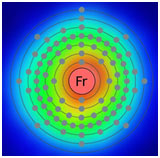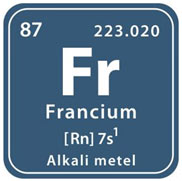Introduction
Francium is a highly radioactive element classed as an alkali metal located in group number 1 and period number 7 of the periodic table. Its atomic number is 87 whereas its atomic mass is 223.
Francium has 87 electrons in a single atom. It contains 87 protons and 136 neutrons in its nucleus. The element Francium is represented by the symbol “Fr”.
Naming and History
Francium was named after the country name “France”. It is because it was discovered in the Curie Institute of France.
- Marguerite Perey
In 1939, Marguerite Perey discovered francium while she was studying and researching the radioactive decay of another radioactive element – actinium- 227. The research was actually started in 1935 when she read the research papers of scientists claiming that actinium has beta particles with energy more than normal.
She started her own experiments and found that actinium activity was caused by alpha particles, not by beta particles. She found that actinium can decay by eliminating the helium nucleus. That nucleus was previously an undiscovered element that she named francium after her country.
The discovery of the element francium completed the discovery of all naturally occurring elements by humans.
Occurrence of Francium
After astatine, francium is the second rarest element present on Earth’s crust. It is an extremely rare element. It occurs naturally in uranium minerals but in extremely trace amounts. It is prepared by bombarding neutrons on radium in nuclear reactors.
The other way of obtaining francium is by bombarding protons on thorium. It occurs as the product of the alpha decay of actinium.
Properties of Francium
Francium is a highly radioactive, unstable, heavy, and least electronegative element in the periodic table. It is not present in vast quantities so most of the chemical and physical properties of francium are unknown. Because of its least electronegativity, it should be highly reactive.
But there are no known reactions with water or other elements. The melting point of francium is between 21 ᵒC to 27 ᵒC. The boiling point of francium is 650 ᵒC. Its density is not known. At room temperature, it exists as solid.
Biological Importance of Francium
There is no known and significant role of francium in living organisms and biological systems. But it is highly toxic due to its highly radioactive nature.

Uses of Francium
- Due to its rarity, instability, and unknown nature, it has no commercial usage. Also, its half-life is only 22 minutes which makes it difficult to use.
- The element is prepared in nuclear reactors and used for research and study purposes.
- It has been used in spectroscopy to some extent.
- It is possible that it might found its usage in the diagnosis of cancer.
Isotopes of Francium
There are 33 known isotopes of francium from mass numbers ranging from 200 to 232. All of them are extremely unstable with half-lives of just a few minutes. The most stable of them all is Fr- 223 with the longest half-life of 21.8 minutes only.
MCQs
- What is the atomic number of francium?
- A) 1
- B) 87
- C) 223
- D) 136
Answer: B) 87
- Who discovered francium?
- A) Marie Curie
- B) Dmitri Mendeleev
- C) Marguerite Perey
- D) Antoine Lavoisier
Answer: C) Marguerite Perey
- Why was francium named after France?
- A) It was discovered in France
- B) It was discovered by a French scientist
- C) It was abundant in France
- D) It was named in honor of the French government
Answer: A) It was discovered in France
- How is francium primarily obtained?
- A) From natural occurrences in uranium minerals
- B) By bombarding neutrons on radium in nuclear reactors
- C) By bombarding protons on thorium
- D) Through chemical extraction from lead deposits
Answer: B) By bombarding neutrons on radium in nuclear reactors
- What is the most stable isotope of francium?
- A) Fr-200
- B) Fr-223
- C) Fr-232
- D) Fr-136
Answer: B) Fr-223
- What is the symbol for francium?
- A) F
- B) Fa
- C) Fr
- D) Fm
Answer: C) Fr
- What is the melting point of francium?
- A) 21°C to 27°C
- B) 0°C
- C) 100°C
- D) 650°C
Answer: A) 21°C to 27°C
- How many known isotopes of francium are there?
- A) 7
- B) 20
- C) 33
- D) 50
Answer: C) 33
- Why is francium considered highly reactive?
- A) Due to its high density
- B) Because of its high electronegativity
- C) Because of its low electronegativity
- D) Due to its stability
Answer: C) Because of its low electronegativity
- What is the half-life of the most stable isotope of francium?
- A) 5 days
- B) 138.9 days
- C) 21.8 minutes
- D) 102 years
Answer: C) 21.8 minutes
- What role does francium play in living organisms?
- A) Essential nutrient
- B) Critical metabolic function
- C) No known role
- D) Key component of DNA
Answer: C) No known role
- Why is francium highly toxic?
- A) Due to its high density
- B) Because of its low electronegativity
- C) Because of its stability
- D) Due to its highly radioactive nature
Answer: D) Due to its highly radioactive nature
- What are the uses of francium?
- A) Commercial applications in industries
- B) Diagnosis of cancer
- C) Food preservation
- D) None of the above
Answer: D) None of the above
- How does francium react with water?
- A) Violently
- B) Moderately
- C) It does not react with water
- D) Slowly
Answer: C) It does not react with water
- What was Marguerite Perey studying when she discovered francium?
- A) Uranium decay
- B) Actinium decay
- C) Radium decay
- D) Polonium decay
Answer: B) Actinium decay
- What is the primary reason for the lack of commercial usage of francium?
- A) High cost of production
- B) Lack of demand
- C) Short half-life and rarity
- D) Toxicity concerns
Answer: C) Short half-life and rarity
- How does francium primarily occur in nature?
- A) As a common element in the Earth’s crust
- B) Trapped in minerals with uranium
- C) As a gas in the atmosphere
- D) As a compound in ocean water
Answer: B) Trapped in minerals with uranium
- What did Marguerite Perey name the new element she discovered?
- A) Franco
- B) Francine
- C) Francium
- D) Franck
Answer: C) Francium
- Which group and period does francium belong to in the periodic table?
- A) Group 1, Period 6
- B) Group 1, Period 7
- C) Group 7, Period 1
- D) Group 2, Period 7
Answer: B) Group 1, Period 7
Summary
In this tutorial, we covered the intriguing characteristics of francium, exploring its occurrence, properties, uses, and isotopes. Francium, classified as an alkali metal, holds a significant position in Group 1 and Period 7 of the periodic table, with an atomic number of 87 and an atomic mass of 223.
Naming and History: Named after France, the discovery of francium by Marguerite Perey in 1939 marked the culmination of the quest to identify all naturally occurring elements by humans.
Occurrence of Francium: Despite its rarity, francium occurs naturally in uranium minerals in trace amounts and can be synthesized by bombarding neutrons on radium in nuclear reactors or by bombarding protons on thorium.
Properties of Francium: Characterized by its highly radioactive and unstable nature, francium remains relatively unexplored in terms of its chemical and physical properties.
Biological Importance of Francium: Although francium holds no known biological significance, its toxicity stems from its highly radioactive nature, posing health hazards.
Uses of Francium: With limited commercial applications due to its extreme reactivity and short half-life, francium finds utility in nuclear research, spectroscopy, and potentially in cancer diagnosis.
Isotopes of Francium: With 33 known isotopes, francium exhibits extreme instability, with the most stable isotope, Fr-223, having a remarkably short half-life of 21.8 minutes.
This tutorial provides a comprehensive understanding of francium, shedding light on its enigmatic properties and its role in scientific exploration.

